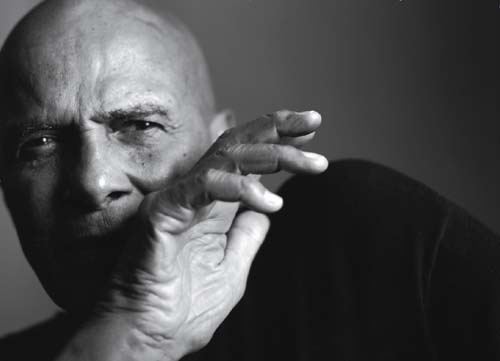Last September, Catherine Heymans, one of the world’s leading cosmologists, was supposed to board a ferry for the northernmost island in the Orkney archipelago. The island, North Ronaldsay, is among the darkest inhabited places on earth. On a clear winter’s night, it is easy to be awed by the thousands upon thousands of stars visible to the naked eye, which spill their unpolluted light upon the Earth. Heymans, who is the first woman appointed astronomer royal for Scotland, was planning to explain to the island’s 60 or so residents that those stars, and the rest of the perceptible universe, represent a mere fraction of the stuff that makes up our cosmos. What she studies is everything we cannot see: the darkness.
Over the past two decades, Heymans, who is 45, has advanced our understanding of a vast, invisible cosmos that scientists are only beginning to comprehend. That “dark universe” is thought to constitute more than 95% of everything that exists. It is made up of entities more mysterious than the ordinary matter and energy – the light, atoms, molecules, lifeforms, stars, galaxies – that have been the subject of scientific inquiry throughout history. In the past 10 years, Heymans has learned that the dark universe shapes the visible cosmos in unexpected ways, and may not follow all the standard rules of physics. Her discoveries are unsettling a broad consensus on how our world works on its grandest scales. “I believe that, to truly understand the dark universe, we will need to invoke some new physics that will for ever change our cosmic view,” she has written.
Heymans is not alone in that belief. During the 20th century, scientists developed an extraordinarily precise account of almost 14bn years of the universe’s history. But an increasing number of scientists suspect that model may be profoundly limited, or even broken. Some leading astrophysicists have recently declared that we have entered an era of cosmological crisis, one that might lead to anything from the discovery of new fundamental particles to a new theory of gravity. “The proliferation of ideas is like nothing I’ve ever seen,” the Nobel prize winner Adam Riess, another key figure in cosmology’s current upheaval, recently told me.
Read the rest of this article at: The Guardian
For decades, whispers have circulated among game show aficionados about a mysterious Jeopardy! contestant from 1986. She went by Barbara Lowe and won five games in a row, which at the time—in just the second season of the reboot hosted by Alex Trebek—was the upper limit for returning champions. Later that year, when the show aired its Tournament of Champions contest with the best recent players, for which five-day champs automatically qualified, Lowe was nowhere to be found. Then, bizarrely, her episodes seemed to be wiped from the face of the earth.
In the 1990s, Game Show Network re-aired Season 2 of Jeopardy!; eagle-eyed fans noticed that the five episodes featuring Lowe were unceremoniously skipped. When the show launched a 24-hour streaming radio program and a Pluto TV channel that broadcast old episodes, Lowe’s episodes still failed to appear. In markets where affiliate stations play reruns on the weekends, Lowe’s episodes are omitted, again and again.
But the why of that matter, and what exactly happened during those games to incur the enduring wrath of the nation’s foremost quiz show, has long proved elusive. This is particularly bedeviling to Jeopardy! superfans, for whom detailed knowledge of operas, world capitals, and even television ephemera looms large. There are few corners of pop culture where facts and certainty are as celebrated as they are on Jeopardy! Yet one day in 1986, something happened—and nearly 40 years later, no one could say what. For the show’s most devoted fans, hunting for clues about Lowe—Jeopardy!’s biggest mystery and, some claimed, its greatest villain—became a calling unto itself.
Read the rest of this article at: The Ringer

Guatemala City looked like a ghost town.
The capital’s 450,000 residents hid in panicked self-quarantine, waiting for the first wave to arrive. World War I–style military planes periodically flew overhead, firing warning shots and dropping leaflets telling people to either flee or stay indoors.
A civil war was moving toward them.
All week, Guatemalan radio had been blasting the news of gruesome battles around the country. The newspapers were going crazy. Two Americans in a tourist plane had been shot down by Guatemala’s Communist army. Refugees were fleeing to Mexico while 400 injured Communist troops were retreating to the capital for medical treatment.
Now, on Saturday morning — June 26, 1954 — radio news broadcasts reported that two columns of anti-Communist patriots calling themselves the “Liberation Army” were 60 kilometers from the capital. And marching fast.
All vehicles were now military targets, the radio warned, so citizens should stay out of their cars. Trains had been stopped due to the intense air battle raging in the northeast. And a sabotage unit of the Liberation Army had just received orders to blow up a bridge in “Sector H-21.”
Soldiers from the Communist government’s own military were now defecting in droves, newscasters reported. Five hundred and thirty-eight civilians had joined the Liberation Army just yesterday.
In response, the government had suspended the constitution. The president had ordered all anti-Communists found on the streets to be rounded up.a
Read the rest of this article at: Narratively
On March 25th, at the first big rally of his current electoral campaign, Donald Trump explained his role in history. In 2016, he told the crowd of supporters, he’d been their “voice.” Now it was different. “I am your warrior, I am your justice,” he announced. “I am your retribution.”
Those words, ominous enough on their own, seemed more so in light of the locale. Trump hadn’t wanted to speak in “one of those fifty-fifty areas,” he explained, but somewhere his support was “close to a hundred per cent.” He chose Waco, Texas, best known for a fifty-one-day standoff outside the city in 1993, between a religious sect called the Branch Davidians and the Department of Justice. The date of Trump’s speech put it during the siege’s thirtieth anniversary.
The siege, which culminated in a fire in the Branch Davidian complex, killed four federal agents and eighty-two Branch Davidians, including their leader, David Koresh. Given Koresh’s messianic tendencies and end-times prophecies, many shrugged this off as just deserts for the zealots from “Wacko, Texas,” as Jay Leno joked at the time.
Yet for others the siege was a sickening display of state power. Waco helped kick the militia movement into high gear. Timothy McVeigh’s biographers Lou Michel and Dan Herbeck said that it was the largest “turning point in his life,” provoking him to bomb a federal building in Oklahoma City on April 19, 1995—the second anniversary of the Waco fire. A young Alex Jones became obsessed with Waco; it led him to start his Web site Infowars.
Waco helped McVeigh, the militias, and Jones see the state as a violent enemy of the people. That view, once marginal, has elbowed its way to the mainstream—it is now Trump’s, too. Where better to insist that the “weaponization of our justice system” is the “central issue of our time,” as Trump did in his Waco speech, than near the place where an F.B.I. raid resulted in dozens of deaths, including those of more than twenty children?
Read the rest of this article at: The New Yorker
Once, more than half a century ago, he was the handsomest man in the world. A radiant man. It was a matter of bearing, of voice and gesture and timing. He had that high, buttery baritone, nothing special really, except, he says, “I knew how to use it”; and that smile, the genuine pleasure that seemed to roll off the so-called King of Calypso in soft little waves; and those eyes, bedroom eyes but darker, almost cadaverous but alert, ready. The eyes revealed the simmer inside. “This hard core of hostility,” a director once said, comparing him to Marlon Brando. That mesmerizing anger. “He’s loaded with it.”
And now? In a diner he asks a kid in a ball cap where he’s going to college. Kid raises his brim and squints up at him—who are you? At a museum he tries to chat up a guard from Jamaica, where down by the docks he learned to sing as a boy. The guard murmurs and smiles. Old man, the guard says with his eyes.
One day we’re walking up Broadway with his wife, Pam. She admires a Porsche, antique and teal. “What year do you think it is?” she asks. Sixty years old, nearly a quarter century his junior, she’s his youthful bride. He walks over to the car’s owner: rumpled and pasty, wearing shorts and an Izod, plugging coins into a meter.
The old man takes out his money roll. It’s fat and bound by a gold clasp. “How much?” he rasps. His voice sounds familiar but scraped down, sharp pebbles beneath sand.
The owner looks at this stranger, his skin the color of dark honey, with a half smile of alarm. “Uh …”
The old man grins, a shining, slightly crooked expression. It’s like a light turning on; you can almost hear the pasty man think, Wait—you’re still alive?
“How. Much.”
Read the rest of this article at: VQR




:format(webp)/cdn.vox-cdn.com/uploads/chorus_image/image/72240973/LostJeopardyTapes_Feat_Getty_JeopardyProductionsInc_Ringer.0.jpg)

